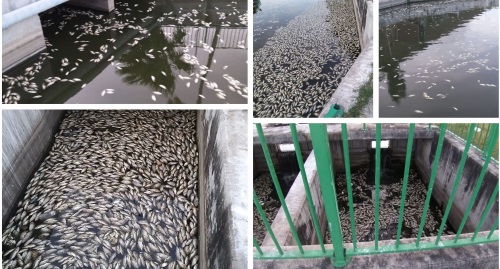 PHILIPSBURG:--- The Nature Foundation St. Maarten received reports of a massive fish die-off in the channel between Great Salt Pond and Fresh Pond in Philipsburg. On Monday the 25th of May, upon arrival at the location an estimated amount of 1000 Tilapia fish already died in the area and was floating in the channel at the Great Salt Pond. A decrease in oxygen levels in the pond water probably caused the massive fish die-off.
PHILIPSBURG:--- The Nature Foundation St. Maarten received reports of a massive fish die-off in the channel between Great Salt Pond and Fresh Pond in Philipsburg. On Monday the 25th of May, upon arrival at the location an estimated amount of 1000 Tilapia fish already died in the area and was floating in the channel at the Great Salt Pond. A decrease in oxygen levels in the pond water probably caused the massive fish die-off.
The Nature Foundation St. Maarten expects that the lack of oxygen in the water due to rising temperatures, absence of rainfall, and an increase of salt concentrations caused the fish die-off. In order to survive all fish use their gills to extract oxygen from water helping them to breathe. With a decrease in oxygen in the water, fish will struggle to survive and eventually die. Other factors that can affect the amount of oxygen in the water are lack of water movement, excess waste, or certain chemical run-off into the pond.
“The cause of death of the Tilapia fish may be a result of the dry weather and heat the island has been experiencing. The depth of the salt pond is 3 to 5 feet deep. Thus when the water level is low the heat penetrates, the saline level rises and the oxygen level decreases. Tilapia fish live mostly in murky freshwater ponds. Thus, as mentioned before when the oxygen level decrease and saline levels rise, the fish start migrating towards the Fresh Water Pond where more oxygen is available. The fishes only reach up until the floodgates located opposite the Illidge road roundabout. The floodgates are blocked off so that only a certain amount of freshwater from the fresh pond is let into Salt Pond daily via these gates, causing the fish to die at this location” explained Chief Ranger Etienne Lake.
The Nature Foundation is also urging the community not to collect or consume the fish from this location. “The water quality is thought to be poor in the Great Salt Pond and it will be impossible to determine how long the fish has been dead. Consuming these Tilapia could affect your health. The incident has been reported to the involved government departments (VROMI), cleanups will be conducted as soon as possible as decomposing fish could cause serious smells and possibly affect the water quality and fish die-off further” mentioned the Manager of the Nature Foundation Melanie Meijer zu Schlochtern. The possibility of water quality testing is also being discussed and the Foundation will keep the public informed of any new information.
A similar incident happened in the area in 2015 and 2013 when several tilapia die-offs occurred probably due to a theorized lack of oxygen in the water in the Great Salt Pond. The area of Great Salt Pond was used to produce salt for export off of St. Maarten in the past. The pond is also connected to the Rolondo Canal, which leads to Great Bay Harbor
The combination of this incident and the rise of sargassum seaweed on the eastern beaches of St. Maarten are indicators that we have entered the summer season where higher temperatures and a lack of rainfall affect our environment. The Nature Foundation urges the community to stay vigilant in these times and ensure that they are not contributing to the wastewater problem by allowing chemical or sewage runoff to enter the natural waters of the island. Poor water quality dramatically affects the environment of St. Maarten.











